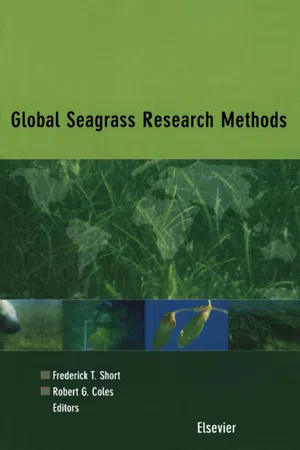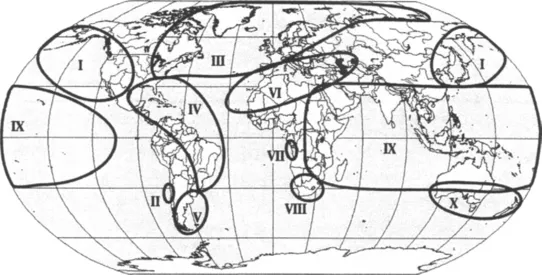1.2 Introduction
Seagrasses are specialized marine flowering plants that have adapted to the nearshore environment of most of the world’s continents. Most are entirely marine although some species cannot reproduce unless emergent at low tide or subject to fresh water inflow. Some seagrasses can survive in a range of conditions encompassing fresh water, estuarine, marine, or hypersaline. There are relatively few species globally (about 60) and these are grouped into just 13 Genera and 5 Families.
Seagrass distribution has been described for most species (den Hartog 1970, Phillips and Menez 1988, Mukai 1993). There is now a broad understanding of the range of species and seagrass habitats. Areas less well known include the southeast Pacific reefs and islands, South America, the southern Atlantic, the Indian Ocean islands, the west African coast, and Antarctica (Figure 1-1). Shallow sub-tidal and intertidal species distributions are better recorded than seagrasses in water greater than 10 m below MSL. Surveying deeper water seagrass is time consuming and expensive, and it is likely that areas of deepwater seagrass are still to be located (Lee Long et al. 1996).
Figure 1-1 Global regions for identifying seagrass distributions (Table 1-1)
The distribution of a seagrass species can be defined as the range over which a species occurs or the area within a location where a particular species is located. In this chapter we consider the former. Detailed mapping protocols for the finer scale distribution questions are in Chapter 5.
With well-recorded events of seagrass loss from many coastal environments (Short and Wyllie Echeverria 1996), it is important to map and record the distribution of not only the location of existing seagrass but also areas of potential seagrass habitat. Such areas are generally shallow, sheltered coastal waters with suitable bottom type and other environmental conditions for seagrass growth Potential habitat may include areas where seagrass was known to grow at some time in the past but from which it has recently been eliminated
Destruction or loss of seagrasses have been reported from most parts of the world (Short and Wyllie Echeverria 1996), often from natural causes, e g, “wasting disease” (den Hartog 1987) or high energy storms (Patriquin 1975, Poiner et al 1989) However, destruction commonly has resulted from human activities, e g, as a consequence of eutrophication (Bulthuis 1983, Orth and Moore 1983, Cambridge and McComb 1984, Short and Burdick 1996) or land reclamation and changes in land use (Kemp et al 1983) Increases in dredge and fill, construction on the shoreline, damage associated with commercial overexploitation of coastal resources, and recreational boating activities along with anthropogenic nutrient and sediment loading have dramatically reduced seagrass distribution (Short and Wyllie Echeverria 1996) Anthropogenic impacts on seagrass meadows continue to destroy or degrade coastal ecosystems and decrease seagrass functions and values, including their contribution to fisheries (Walker 1989) Efforts are being made toward rehabilitation of seagrass habitat in some parts of the world: transplantation, improvement of water quality, restrictions on boating activity, fishing and aquaculture, and protection of existing habitat through law and environmental policy (Chapter 23)
A number of general parameters are critical to whether seagrass will occur along any stretch of coastline (see color plates) These include physical parameters that regulate the physiological activity of seagrasses (temperature, salinity, waves, currents, depth, substrate and day length), natural phenomena that limit the photosynthetic activity of the plants (light, nutrients, epiphytes and diseases), and anthropogenic inputs that inhibit the access to available plant resources (nutrient and sediment loading). Various combinations of these parameters will permit, encourage or eliminate seagrass from a specific location.
The depth range of seagrass is most likely to be controlled at its deepest edge by the availability of light for photosynthesis. Exposure at low tide, wave action and associated turbidity and low salinity from fresh water inflow determine seagrass species survival at the shallow edge. Seagrasses survive in the intertidal zone especially in sites sheltered from wave action or where there is entrapment of water at low tide, (e.g., reef platforms and tide pools), protecting the seagrasses from exposure (to heat, drying or freezing) at low tide.
It is important to document seagrass species diversity and distribution and identify areas requiring conservation measures before significant areas and species are lost. Determining the extent of seagrass areas and the ecosystem values of seagrasses is now possible on a local scale for use by coastal zone managers to aid planning and development decisions. Knowledge of regional and global seagrass distributions are still too limited and general for broad scale protection and management. Such infor...

